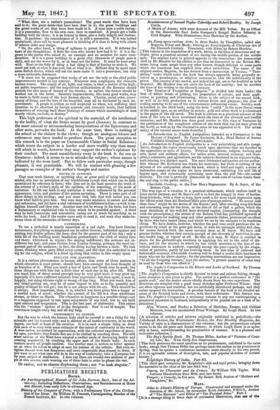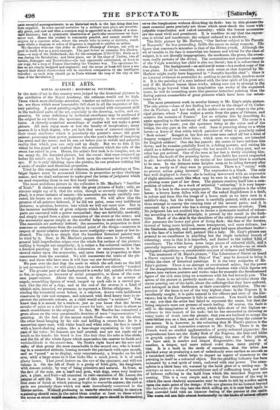PUBLICATIONS RECEIVED.
BOOKS.
An Autobiographical Memoir of Sir John Barrow, Bart., late of the Ad- miray ; including Reflections, Observations, and Reminiscences at Home and Abroad, from early Life to advanced Age.
History of the Conquest of Peru; with a Preliminary View of the Civilisa- tion of the Incas. By William H. Prescott, Corresponding Member of the French Institute, &c. In two volumes. Reminiscences of Samuel Taylor Coleridge and Robert Southey. By Joseph Cottle.
A Sketch of Assam; with some Account of the Hill Tribes. By an Officer in the Honourable East India Company's Bengal Native Infantry in Civil Employ. With illustrations, from Sketches by the Author.
An Essay upon various Arts; in three Books, by Theophilus, called also Rugerus, Priest and Monk; forming an Encyclopreclia of Christian Art of the Eleventh Century. Translated, with Notes, by Robert Hendrie. [This volume is the translation of a work, which, in the form of directions and re- ceipts, gives a practical account of art during the middle portion of the middle ages. The original Latin is printed opposite to the translation: the manuscript used by Mr. Hendrie for his edition is one that he discovered in the British Mu- seum; being more ample than any other known, though deficient in some parts which the translator has supplied from other authorities. The name of the original author, &gems, he has derived from a manuscript at Vienna; " Theo- philus," under which name the book has always appeared, being generally re- ceived as a pseudonyms, or religious surname to sink the individuality in the priest. The country of the author, and indeed his age, are so far doubtful as to be disputed. Mr. Hendrie does not settle the land of his nativity; but he ascribes the time of his writing to the eleventh century. " The Treatise of Theophilus or Rugerus is divided into three books; the first of which treats of gilding, the preparation of colours, and their appli- cation in painting and illuminating. Glass is the subject of the second book, as well in its first production as in various forms and purposes; the time of cooling seeming to be one of the circumstances influencing colour. Smith's work is handled in the third book; using the term " smith" in the more liberal sense of the middle ages, as an artificer in metals: gold and silver work is predominant in the pages of the old monk. The book is curious as a practical account of the state of the arts we have mentioned about the time of the eleventh and twelfth centuries; and Mr. Hendrie has done good service to this class of literature by the publication of the completest edition of the work that has yet been given to the world, as well as by the illustrative notes he has appended to it. The actual utility of the treatise seems more doubtful.] An Introduction to English Antiquities; intended as a Companion to the History of England. By James Eccleston, B.A., Head Master of Sutton Coldfleld Grammar School, Warwickshire. [An Introduction to English Antiquities is a very painstaking and able compi- lation, though the topics occasionally touch upon questions that are handled in the appendices or notes of history. Political institutions, religion, learning and arts, naval and military affairs, (or rather arms, internal economy, and disci- pline,) commerce, and agriculture, are the subjects discussed in six separate books, each relating to a distinct epoch. The most celebrated antiquaries are the author- ities whence Mr. Eccleston has drawn his materials; but there is nothing of the dryness of the antiquarian about his book, which is brief and rapid; a series of instructive essays on the topics we have mentioned, exhibiting the still life of bygone ages, and occasionally something more than the still life—the actual manners. The text is profusely illustrated by wood-cuts of various kinds, kom the seal-ring to the public edifice.) Charitable Cookery; or the Poor Man's Regenerator. By A. Soyer, of the Reform Club. - [The true sign of a vocation is a practical enthusiasm, which realizes itself in some useful purpose; and M. Soyer's call is to feed the hungry in time of famine. Soup-kitchens, with a view to soup, have made a far more rapid impression upon the official mind than did Rowland Hill's plan of postage reform. " No sooner said than done," might be the device of the Boyers; and, after erecting soup-kitchens and concocting soup for the Irish, it the rate of 3d. or 3id a gallon, which the most fastidious of the well-fed have declared capital, (comparing the 'draught with the prescription,) the artiste of the Reform Club has published upwards of twenty receipts for making soup and other palatable dishes, pronounced excellent by those who have tasted them, and which we see by the estimate to be wondrous cheap. We have doubts, however, whether the poor man could purchase the in- gredients by retail at the price put down, or with his untaught ability and slen- der means furnish forth the same savoury mess as M. Soyer. We have still greater doubts, whether they contain enough of the elements of nutrition to sus- tain health long, or vigour at all. Be this as it may, M. Soyer is entitled to praise for his philanthropic exertions in applying his art to the relief of dis- tress, and for the manner in which he has culled attention to the loss of nu- tritious substance in cookery, especially among the poor—partly by the evapo- ration of particles, partly by not evolving them. In this time of enforced and fashionable economy, Charitable Cookery will be found a useful little brochure to many who are far above charity; for the pinching instructions are not imperative. "In all the foregoing receipts," says the author, "a greater quantity of meat may be used by those who can afford it.")
The Angler's Companion to the Rivers and Lochs of Scotland By Thomas Tod Stoddart.
[The Angler's Companion is chiefly devoted to trout and salmon fishing, though some attention is also given to pike. The author is a perfect enthusiast the gentle craft," and the matter seems chiefly drawn from his own experience. The directions are mingled with a good many sketches after Professor Wilson: they are often vigorous and truthful, but too artificially introduced perhaps, and they rather suspend the instruction. A peculiar feature of the book is its detailed ac- count of the Scottish lochs and rivers, with their tributaries. This feature ren- ders The Angler's Companion a necessary volume to any one contemplating a piscatorial excursion in Scotland, independently of its general use as a book of in- structions.] Men, Women, and Books; a Selection of Sketches, Essays, and Critical Memoirs, from his uncollected Prose Writings. By Leigh Hunt. In two volumes.
[A selection of articles and reviews originally published in periodicals,—the Edinburgh Review, the Westminster Review, the New Monthly Magazine, &c. Variety of topic is a characteristic of the volumes; but the predominant subject seems to be the old poets and female writers; in which Leigh Hunt is so agree- ably at home, notwithstanding his peculiarities of manner. It is a pleasant and recreative collection.] The Boy's Spring Book. By Thomas Miller, Author of "Pictures of Coun- try Life," &c. With thirty-five Illustrations. [This book possesses the same qualities as its predecessors, exhibited in the same mode; except that Thomas Miller has perhaps made the author so far prominent in Spring, that he speaks a continuous narrative more directly in his own person. It is an agreeable volume of description, tale, and popular sketches of natural history esghtley's History of India. Part III. [This third part completes Mr. Keightley's able and rapid précis; bringing down the narrative to the close of the late Sikh war.] Popery, its Character and its Crimes. By William Elfe Tayler. With fourteen Illustrations from MSS. and rare books. Temper; a Comedy, in five acts. By Robert Bell, Author of "Mothers and Daughters," &c.
MAPS.
Atlas to Alison's History of Europe. Constructed and arranged. .under the direction of Mr. Alition by Alexander Keith Johnston, F.K.U.S.i Author [It is a strange thing in these days of overloaded illustration, that ass of the " and. Editor of " The Physical Adm." Part of "The National
mist essential accompaniments to an historical work is the last thing that has been supplied. In some special narrative by a military man plans arc occasion- ally given, and now and then a common mup is appended to an edition of a stan- dard historian • but a systematic illustration of particular occurrences we have never met. Hence the student is constantly puzzled, and cannot resolve the enigma by a common atlas, where the events refer to towns or districts, much more where a diagram or series of diagrams is required to exhibit an action.
We therefore welcome this Atlas to Alison's History of Europe, not only as good in itself, but as a good. example. The part before us contains five illustra- tions,—a map of the Netherlands, &c. for the campaigns 1792-179e; Paris as it was during the Revolution; and three plans, one of the siege of Toulon, two of battles, Jemappes and Neerwinden—the last apparently substituted, at least in our copy, for a map of France illustrating the V entiesn war. The specimens be- fore us are clearly designed and engraved; and the maps at least will have a use beyond their direct object—they will be excellent companions to the intelligent traveller: no such man should go to Paris without the map of the city at the time of the Revolution.]



























 Previous page
Previous page